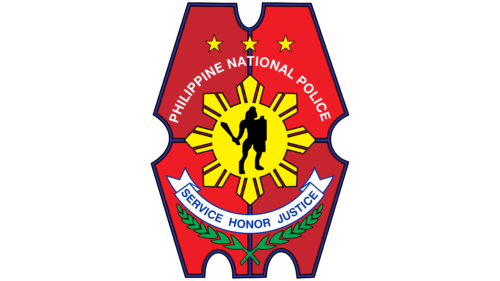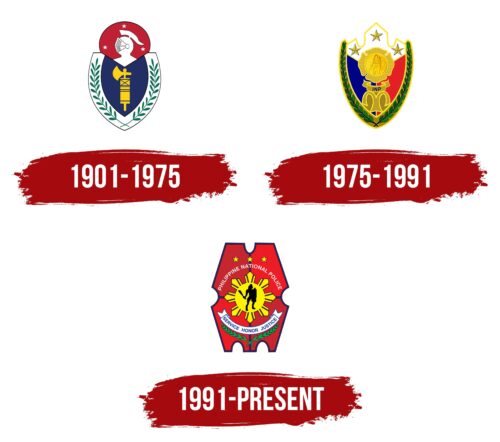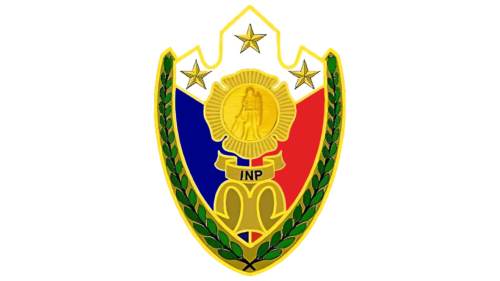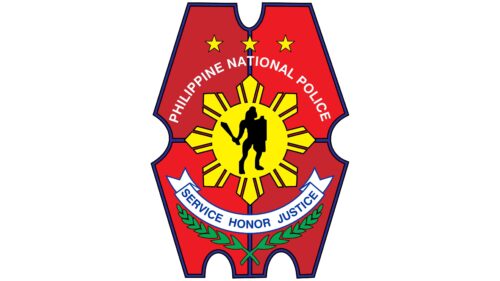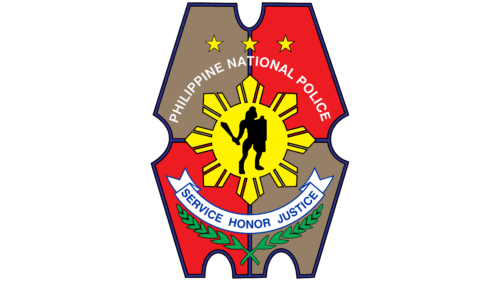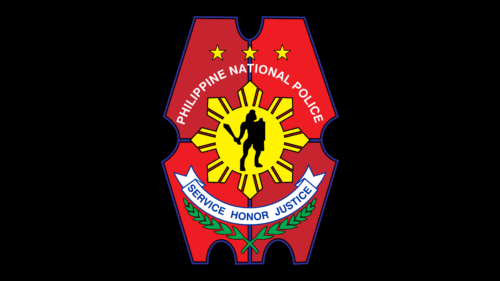The PNP logo conveys this body’s importance, solid status, and significance for the local population. To fully convey this message, the designers chose a complex multi-component format.
It provides for the use of more than two elements in the logo, which are harmoniously combined into a single whole that reflects the essence. There are quite a few components in the Philippine National Police emblem. Among them, one can single out a common frame divided into four zones, two inscriptions, several stars, two branches with leaves, a central detail in the form of the sun, and an image of a warrior with a shield. Each figure describes a specific characteristic of the Philippine National Police.
PNP: Brand overview
| Founded: | August 18, 1901 |
| Headquarters: | Camp Crame, Quezon City, Philippines |
| Website: | pnp.gov.ph |
PNP is the abbreviation for law enforcement in the Philippines. Its full name is the Philippine National Police. The armed unit is managed by two structures at once: the local government organization (DILG) and the Ministry of the Interior.
The PNP is a modern armed organization that was formed based on several structures. They followed the rule of law in the Philippines at different times. Before the arrival of Spanish rule on the territory of the state, the duties of the police were carried out by local soldiers. Later, the Spanish army and local militias were engaged in law enforcement. A few years later, two organizations appeared that became the basis for creating the Philippine National Police.
Meaning and History
During its existence, the Philippine National Police changed its corporate logo several times. The main reasons were improvement, reform, and reorganization. Each such change also required changes at the visual identity level, so at certain intervals, PNP had a new emblem. The current version is the most thoughtful of all the options presented. It fully reflects the state structure’s essence, values , and features.
What is PNP?
The PNP (Philippines National Police) is the name of the armed law enforcement agency that maintains law and order in the Philippines. The headquarters of the division is located in Quezon City. The organization is currently controlled by the mayors of the municipalities, as well as by the National Police Commission. The DILG (local government) is responsible for training and equipping the necessary ammunition.
1901 – 1975
The history of the PNP dates back to 1901. It was then that the Manila Police District and the Philippine Police were established. After some time, these structures joined the Armed Forces of the Philippines. The reorganization did not end there. In 1990, the United National Police and the Police Department merged. As a result of this, the Philippine National Police (Philippine National Police) appeared.
The new organization received its first corporate logo. It was a complex picture consisting of inscriptions, frames, and graphic symbols. The lower part resembled the shape of a warrior’s shield. Inside it was two branches crossed at the ends, as well as an image of an object resembling a weapon. All this was complemented by a rounded upper part, in the center of which was a drawing of a knight’s helmet. Around it was three miniature stars.
The composition symbolizes valor, courage, trustworthiness, protection, and nobility. This is what characterizes this law enforcement agency directly. In addition, due to the combination of the presented elements, the icon is quite recognizable. The expressive coloring also contributes to this. The logo uses blue (demonstrating trust), yellow (denoting energy), red (symbolizing courage), white (reflecting responsibility), and green (the color of calm and comfort).
1975 – 1991
In 1975, the law enforcement agency changed its logo. The updated picture was in many ways similar to the state flag of the Philippines. It was a large frame, similar to a shield, but with three pointed tops. Along the edges, the figure is decorated with two branches, which, according to the designers’ idea, were associated with a laurel tree – a symbol of peace and goodness. There were also three neat stars on the pointed tops, which looked like the figures on the country’s flag.
In the center of the emblem was placed a symbol resembling the sun with the image of a knight inside. This element also has similarities with the elements of state symbols, and the figure of a warrior was a direct reference to the organization’s activities. Under the stylized sun on the emblem was placed a ribbon with the inscription INP. The color scheme was dominated by red, blue, white, and gold hues, which are also present on the flag of the Philippines.
A dark green shade was also used here (leaves of laurel branches are decorated). Due to the specified elements and colors, the PNP badge is directly associated with government agencies. Thematic icons emphasize its character and direction in the form of an image of a knight and a wordmark.
1991 – today
In 1991, the visual concept of PNP was formed, which is still used today. This is a modern detailed logo created according to the traditional scheme for this institution. All content was located inside a frame resembling a modernized law enforcement shield. It is divided into four parts and has small indentations on the sides. In the center of the stylized shield is a symbol that resembles the sun.
Its eight rays symbolize the eight provinces that rebelled against Spanish rule. A similar sign is placed on the flag of the country. Another element of the state symbols is located at the top of the logo – these are three bright stars. Immediately below them, you can see directly the name of the Philippine National Police, made in simple roman type. In addition, the verbal part includes the inscription Service Honor Justice, placed on a stylized white ribbon.
It stands for the main motto of the Philippine National Police – service, honor, and justice. There are also laurel branches here. They denote regional law enforcement commands. In the sun’s center is an image of a key figure – the legendary ruler Lapu-Lapu. He is considered a national hero in the country and represents the civil power of the constitutional type.
Font and Colors
The PNP logo uses two wordmarks that have an identical design. Service Honor Justice and Philippine National Police inscriptions are made with straight, laconic sans-serif lines. The letters look quite strict and simple, emphasizing rigor and compliance with certain rules. Expressive colors complement the concept.
It is based on blue, red, white, yellow, and green colors. Some of them are similar to the colors of the flag, which symbolize patriotism and devotion. Green, in this concept, stands for calm, comfort, and safety, which are law enforcement goals.
PNP color codes
| Neon Yellow | Hex color: | #fef201 |
|---|---|---|
| RGB: | 254 242 1 | |
| CMYK: | 0 5 100 0 | |
| Pantone: | PMS 3955 C |
| Pigment Green | Hex color: | #04a551 |
|---|---|---|
| RGB: | 4 165 81 | |
| CMYK: | 98 0 51 35 | |
| Pantone: | PMS 354 C |
| Pigment Red | Hex color: | #ee1c24 |
|---|---|---|
| RGB: | 238 28 36 | |
| CMYK: | 0 88 85 7 | |
| Pantone: | PMS Bright Red C |
| Fire Engine Red | Hex color: | #c6252f |
|---|---|---|
| RGB: | 198 37 47 | |
| CMYK: | 0 81 76 22 | |
| Pantone: | PMS 1788 C |
| Royal Azure | Hex color: | #0138a8 |
|---|---|---|
| RGB: | 1 56 168 | |
| CMYK: | 99 67 0 34 | |
| Pantone: | PMS 286 C |
| Cosmic Cobalt | Hex color: | #2d3091 |
|---|---|---|
| RGB: | 45 48 145 | |
| CMYK: | 69 67 0 43 | |
| Pantone: | PMS 2746 C |
| Black | Hex color: | #000000 |
|---|---|---|
| RGB: | 0 0 0 | |
| CMYK: | 0 0 0 100 | |
| Pantone: | PMS Process Black C |
